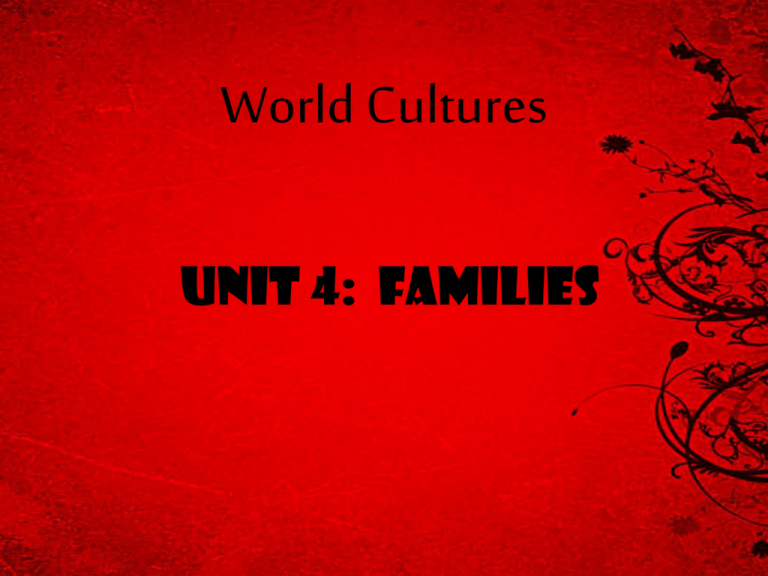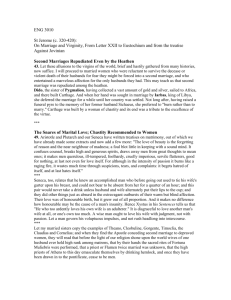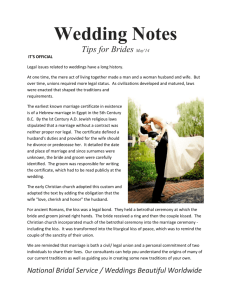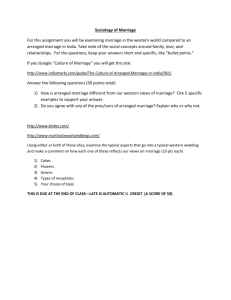
World Cultures
Unit 4: Families
I. Mate Selection
A. Free Marriage
1. Choose a mate independently based on personality or
traits that you like
B. Arranged Marriage
1. Family members decided who you will marry
2. Often established in early childhood
a. Early identification as a couple helps in the maintenance of
the relationship
3. Reasons for arrangement
a. Economics: keeping family wealth or expansion of wealth
b. Political: keeping or expanding political power
c. Race/ethnicity
d. Social class: Caste system
SB V U2 L8 Marriage Is an Arrangement
Agenda
Voices of Modern Culture
Essential Question: What are some elements of
family conflicts about arranged marriages?
I.
II.
III.
IV.
Review: Bend It Like Beckham
Quickwrite: Arranged Marriage
Exploring Knowledge: Arranged Marriage
Reflection: Bend It Like Beckham
Review: Bend It Like Beckham
Review your notes from the Bend It Like
Beckham, particularly notes about wedding customs
and marriage.
What’s the difference between a “love match”
and an arranged marriage?
Quickwrite: Arranged Marriage
By yourself, complete the quickwrite on page 82.
Would you accept an arranged marriage? Why or why
not?
Exploring Knowledge: Arranged Marriage
Before reading the article, what do you think might be the
benefits (pros) and drawbacks (cons) of an arranged marriage?
Pros
Cons
Exploring Knowledge: Arranged Marriage
As you read the article, keep track of the pros and cons as they are
presented in the article.
Pros
Cons
Reflection: Bend It Like Beckham
By yourself, complete the reflection on
page 83.
What pressures do you think Jess in Bend It Like
Beckham may feel about marriage from her
family and culture? How do you expect that she
will feel?
4. Examples:
a. Japan
i. A middle man puts together a list of
potential mates = chose from a menu
b. Egypt
i. Secret observations: men go to places women
gather and pick one they like to ask their parents
about
C. Theories
1. Endogamy
a. Identifies the specific groups that a mate must be chosen
from (most like your own)
b. Prohibits marriage outside of your own race, ethnicity,
religion, social group
c. Intended to reinforce the cohesiveness of a group
d. Examples:
i. Amish: must marry other Amish
ii. Yaruros of Venezuela: must marry a cousin
chosen by the uncle
of the male
2. Exogamy
a. Requires mate selection from outside of certain groups
b. Widen genetic mixing
c. Incest Taboo: no marriage or sexual relations with specified
relatives
i. Forbidden in 95% of all cultures
d. Homosexuality: no marriage or sexual relations with the
same gender
i. Forbidden in 92% of all cultures
3. Love
a. Not viewed as needed in some relationships
i. Some areas religion & economic needs are more
important
ii. US & Western Europe place a high degree of
importance on Love
a. Bonded/friend to create a new life with
away from parents
II. Marriage vs. Mating
A. Marriage
1. Union of 2 or more individuals for sexual & economic
aspects that is supported by religious institutions &
society
a. Exclusive bond
B. Mating
1. Sexual relations for various reasons
2. Non-exclusive
3. Controlled by laws & social rules
a. Age, race, gender, blood or
marriage relation to person
Mate Selection Ritual
Fulani: males paint their faces,
dress in bright colors, and
dance to attract a wife or
wives.
Video Clip on Mating
Start at 12:30, end at 23
III. Marriage Types
A. Monogamy
1. Marriage between two individuals
2. Most common form of marriage
3. Serial Monogamy
a. A person marries, divorces, marries,
divorces, etc….. one person at a time
b. Reasons: economics, love,
companionship, abuse
Traditional Jewish Wedding Video Clip
B. Polygamy
1. Having multiple spouses
2. Most common in areas that are:
a. Torn by war
b. Governed by Islam or Mormons
c. Agricultural areas, where more kids are an advantage
d. More of one gender than the other
3. Types of Polygamy
a. Polygyny
i. One man marries multiple women (most common form)
ii. Men can only have as many wives as he can provide for
iii. Examples:
Muslim Nations
Africa
Fundamentalist
Mormons
Spotlight on a Young Polygamist Family Video
The Story Continued Polygamist Family Video
Inside Polygamy: Fundamentalists: 50 minutes
b. Polyandry
i. One woman marries multiple men (only practiced in .5% of
cultures in the world)
ii. Most common form is where a woman marries all of the
brothers in a family
iii. Practiced where family land is inherited through men, do not
want to cut it down
iv. Examples:
Nepal
Indonesia
Brothers Share One Wife Part 1
Brothers Share One Wife Part 2
Multiple Husbands: Nat Geo
c. Group Marriage
i. Many men and many women all married to each other
ii. Examples:
Communal Marriage: Indonesia
Polyamorous Family Video Clip
d. Special Case: Non-sexual same-sex marriage
i. Nandi in Kenya
a. Male dominate society &
inheritance goes through
male line
i. Wife is infertile = no male heir
ii. Wife marries a younger woman & becomes the
new wife’s “Husband”
iii. Male can then try for new children with the new wife
iv. Child is their shared offspring
Other Marriage Concerns/Forms
Too Young to Marry Video
Incarceration Generation Video
IV. Marriage Customs
A. Bride Price
1. Money transferred from groom
or his family to Bride’s family
a. Compensation for loss of a daughter from the family
B. Bride Service
1. Grooms works for a set period of time for the
Bride’s family
a. Compensate for loss of a daughter, prove worthiness
as a husband
C. Dowry
1. Money given by the Bride’s family to the Bride and/or
Groom
a. Financial support for the new family
2. Usually belongs to the wife: goes with her if divorced
D. Gift Exchange
1. Families exchange gifts
a. Promotes an inner-family bond
E. Daughter Exchange
1. Female relative of the Groom marries a male relative of the
Wife
a. Maintains family size
b. Creates additional bonds between the two families
V. Divorce: ending a marriage
A. Steps/areas of impact in a divorce
1. Emotional detachment
2. Legal process & grounds for it
3. Economic effects
4. Co-parental rights
5. Community divorce
a. Changes in friends & institutional ties
6. Psychological
a. Gaining autonomy, self-esteem issues,
creating a new identity
B. Factors for higher divorce probabilities
1. Marriage at a young age: (15-19)
2. Short acquaintance/courtship before (less than 1 year)
3. Short or no engagement period (less than 6 months)
4. Acceptance by family members (parents especially)
5. No/few common interests
6. Belonging to different faiths/religions
7. Failure to attend religious services
8. Disagreement on authority or child rearing
9. Urban backgrounds
10. Economic hardships or disagreements
US Divorce Rates
1920: 13.4 out of 100
1930: 17 out of 100
1940: 16.9 out of 100
1950: 26.6 out of 100
1960: 25.8 out of 100
1970: 32.8 out of 100
1980: 49.7 out of 100
1990: 51.3 out of 100
2000: 40 out of 100
2010: 36 out of 100
SB V U2 L2 Family and Tradition Agenda
Voices of Modern Culture
Essential Question: What are some ways family
that family can be defined?
I.
II.
Quickwrite: Family and Culture
Culture and Family: Defining Family
Quickwrite: Family and Culture
By yourself, quickwrite about an experience
that you have had with family (your own or another)
that connects to the idea of culture.
Culture and Family: Defining Family
How do family and culture connect? record your ideas
in the following Venn diagram:
Both
Family
Culture
Culture and Family: Defining Family
Our Working Definition of Family:
VI. Family
A. Social institution that is present in every culture in various
forms
B. Functions of the Family
1. Reproduction
2. Protection
3. Socialization
4. Regulation of sexual behaviors & relations
5. Affection & companionship
6. Social status
7. Care for elder members
C. Forms of the Family
1. Family of Orientation
a. Family you are born & raised in
2. Family of Procreation
a. Family that you start with your spouse
3. Nuclear Family
a. Parents & unmarried children
b. Serves as the core of all family
groups
c. Steadily declining due to divorce
& other situations
4. Blended Families
a. Husband, wife, & unmarried children
from other marriages
5. Foster/Adopted Families
a. 1 or more adult guardians
& children not of their own
6. Single Parent Families
a. Only 1 parent & their unmarried children
i. Most common in industrial nations & war zones
ii. Most often the mother & children (60-70% of the cases)
7. Extended Families
a. Multiple generations of one family living together
i. More people to help in the raising of children & providing
money
8. Alternative Household Arrangements
a. Kibbutz/Communes
i. Group of individuals & families joined into an economic
& social community
ii. Marxist theories started the trend in 1910
a. Collective farming
b. Share all aspects of the community: limited personal
ownership
c. All members are involved in governing the group,
raising the children, & resolving conflicts
D. Family Authority Patterns: Who controls the family
1. Patriarchy
a. Males are expected to dominate the family
i. Usually the eldest male or the husband
b. Women tend to have low status
c. Examples:
Muslim Nations
Rural China & Asia
d. Expected Behaviors of Saudi Arabian Women
i. Be very modest & respectful to males
ii. Faces covered in public (veil), wear long sleeves, long skirt, &
head covering
iii. Men & women must be segregated in public
iv. Women have the same religious duties as men, but they
must pray at home
v. Women cannot inherit property or own it
vi. If they want to travel
a. Get written permission from a male family member to
board an airplane or stay in a hotel without her husband
vii. Only receive a public education with the permission of parents
a. Not allowed to have contact with boys at the school or men
viii. Women are not allowed to work in a career that brings them
into contact with men
a. Can’t sell men’s clothes, work in a doctor’s office with male
patients
ix. Illegal to be photographed in public or without their veil on
x. Husband can divorce a wife by stating “I divorce you!” three
times in public with witnesses
a. Women cannot divorce usually, & if they can the
children remain with the father
xi. Men: adultery is a minor offense, Women: may be
killed for the crime
2. Matriarchy
a. Women are expected to dominate the family
i. Usually the eldest female or wife
b. Men have lower status
c. Examples:
Native American tribes
Not Without My Daughter
Part 1
Part 2
Part 3
Part 4
Part 5
Part 6
Part 7
3. Egalitarian
a. Spouses are regarded as equals in the family
b. Both split the responsibilities & the power
c. Example:
United States
E. Family Residence Patterns
1. Where the new family lives is determined by the culture
2. Neolocal: expected to create a separate household
3. Patrilocal: live near or with the Husband’s family
4. Matrilocal: live near or with the Wife’s family
F. Decent Patterns
1. How a person’s linage & kinship is tracked for inheritance,
emotional ties, social status
2. Bilateral
a. Mother’s & father’s is equally
important
3. Patrilineal
a. Only the Father’s lineage is
important
4. Matrilineal
a. Only the Mother’s lineage is
important
G. Family & Kinship definitions
1. Descent: the cultural recognition of kinship connections
between a child & the parent’s kin
2. Kindred: a kinship group that consists of the blood relatives
of the individual & their spouse
3. Sibling: a brother or sister
4. Cousin: children of our parent’s brothers & sisters
a. Cross cousin: child of the father’s sister or Mother’s Brother
b. Parallel Cousin: child of the Father’s brother or the
Mother’s sister
Family Tree Symbol Key
I’m My Own Grandpa
Now that we have practiced with decent tracking
its time to put those skills to the test by taking the
family talked about in the following song and
charting it using the symbols discussed and practiced
in class.
I’m My Own Grandpa Video









